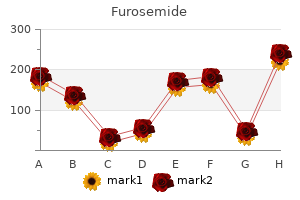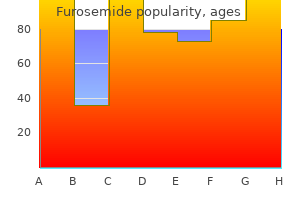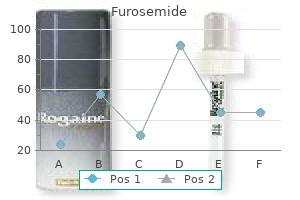Furosemide
"Furosemide 100 mg generic, pulse pressure 28".
By: B. Abbas, M.S., Ph.D.
Vice Chair, University of Oklahoma College of Medicine
Medical therapy is generally preferred for open-angle glaucoma and it should be instituted as soon as the disease is diagnosed arrhythmia nursing care plans proven furosemide 100mg. The drugs used act either by decreasing the rate of aqueous formation or by increasing the rate of aqueous outflow heart attack 42 year old purchase furosemide 40 mg visa, or both arteria bologna 8 marzo 2014 discount furosemide express. The medical treatment that achieves this goal with lowest risk and fewer side effects should be employed blood pressure healthy numbers discount 40 mg furosemide free shipping. Then he drinks approximately one liter of cool water within a span of five minutes. The intraocular pressure is measured at 15 minutes intervals for one hour or until the pressure stops rising. A rise greater than 8 mm Hg is suggestive of a pathological response seen in patients of open-angle glaucoma. The rise in intraocular pressure induced by water intake is probably due to the transfer of water from diluted blood into the more concentrated aqueous humor. It is suggested that a positive response of water-drinking test is a function of baseline intraocular pressure and may not be related with presence or absence of glaucoma. It is judged by the stabilization of the visual field defects and evaluation of the appearance of optic nerve head. The reduction of intraocular pressure can be obtained medically, surgically or by a combination Adrenergic Drugs Nonselective Epinephrine (adrenaline) Dipivalyl epinephrine Selective Clonidine Apraclonidine hydrochloride Brimonidine Beta-blockers Nonselective Timolol maleate Levobunolol Carteolol Metipranolol Selective Betaxolol Glaucoma Prostaglandins Latanoprost Travoprost Bimatoprost Unoprostone 233 Carbonic Anhydrase Inhibitors Systemic Acetazolamide Dichlorphenamide Methazolamide Topical Dorzolamide Brinzolamide Practically all miotics produce side effects due to miosis which include diminished night vision, reduced visual acuity, particularly in the presence of axial lens opacities, myopia due to spasm of accommodation and generalized constriction of visual field. Adrenergic Agonist Adrenergic agonists are divided into selective and nonselective agents. Nonselective Adrenergic Agonist Epinephrine and dipivefrin increase the trabecular and the uveoscleral outflow. Nonselective adrenergics are replaced with a more effective selective alpha 2- adrenergic agonists. Side effects like ocular irritation, blepharoconjunctivitis, conjunctival pigmentation, precipitation of angle-closure glaucoma (due to mydriatic effect), cystoid macular edema, elevated blood pressure and cardiac arrhythmias may occur. Dipivalyl epinephrine (dipivefrin) is a prodrug which is converted into epinephrine after absorption into the eye. It is superior to epinephrine because of better corneal penetration, greater hypotensive effect (10 times greater than epinephrine) and fewer side effects. Cholinergic Drugs the cholinergic agents used are those having a direct parasympathomimetic effect resembling the action of acetylcholine at the receptor sites. Pilocarpine is a parasympathomimetic drug which is currently less frequently used in openangle glaucoma. The pressure lowering effect of pilocarpine begins within 20 minutes and reaches its peak in about 90 minutes and lasts for 4 hours. For a slow and sustained release of the drug, pilocarpine may be administered by ocuserts or in soaked hydrophilic contact lenses. Ocuserts are available as Pilo-20 system (1% solution) and Pilo-40 system (2 to 4% solution). They can be inserted either in the lower or upper fornix for a constant release of a steady concentration of the drug for 7 days. Selective Alpha-2 Adrenergic Agonist the mode of action of alpha-2 adrenergic agonist is not fully understood. It decreases the aqueous production and episcleral venous pressure and improves the aqueous humor outflow. The drug should be used with caution in patients with cardiovascular and obstructive pulmonary disorders. Carteolol hydrochloride (1%), a nonselective -blocking agent with associated sympathomimetic activity, is effective in lowering the intraocular pressure maximally 4 hours after the instillation. Topical betaxolol lowers the intraocular pressure by 15-20% and the peak reduction is noted within 2-3 hours after the instillation in normal and glaucomatous eyes. Betaxolol is the topical beta-blocker of choice in patients with open-angle glaucoma associated with pulmonary problems. However, respiratory difficulties are noticed after the use of betaxolol in certain susceptible and high-risk patients. Apraclonidine hydrochloride, a selective alpha-2 adrenergic agonist, is available as 0.


Chisholm A arteria lienalis furosemide 100mg discount, Mann J pulse pressure 80 purchase furosemide 40 mg without prescription, Sutherland W heart attack during sex cheap 100mg furosemide overnight delivery, Williams S hypertension knee buy furosemide 100mg low price, Ball 20 21 22 23 24 25 M Dietary management of patients with familial hypercholesterolaemia treated with simvastatin. Fish oil supplementation in patients with heterozygous familial hypercholesterolaemia. Effects of a soy protein beverage on plasma lipoproteins in children with famililal hypercholesterolaemia. Efficacy and safety of cholestyramine treatment in peripubertal and prepubertal children with familial hypercholesterolaemia. The chief characteristics are retinitis pigmentosa, anosmia, peripheral neuropathy, deafness and ataxia. Other manifestations, usually associated only with extremely high levels of phytanic acid, include ichthyosis and cardiomyopathy. This unusual isoprenoid 20 carbon branched chain fatty acid is normally rapidly degraded in the human body. The main difference between these groups is that the peroxisomal biogenesis disorders have several defective metabolic functions and tend to present in infancy with severe clinical symptoms (including mental and physical retardation), while in the single enzyme peroxisomal disorders presentation is often later and the peroxisomal structure is intact. In both groups of disorders there may be high levels of phytanic acid in the plasma and fat containing tissues. Normal metabolism of phytanic acid involves peroxisomal -oxidation, but an additional low capacity pathway through omega-oxidation and subsequent cycles of -oxidation exist [4,5]. The onset of symptoms is usually slow and diagnosis is often not made until the second to fifth decade of life, although some patients have been diagnosed in early childhood [1,6,7]. There is usually no developmental or mental retardation, but this has been reported in one child where symptoms presented at 7 months. Phytanic acid is exogenous in origin being derived from the side-chain of chlorophyll and treatment is aimed at reducing plasma and tissue levels by means of a diet low in phytanic acid, which must be followed for life. Reduction of plasma phytanic acid levels significantly improves peripheral nerve function, ichthyosis and cardiac arrhythmias; it cannot, however, reverse the damage done to the sensory nerves, although further deterioration can be arrested. It is thought that in the case of young children, early diagnosis and treatment could delay or prevent the development of these irreversible lesions. The aims of dietary treatment are to: l Peroxisomal biogenesis disorders Patients with global peroxisomal biogenesis defects can also show raised plasma levels of phytanic acid [8]. These metabolic defects result in severe clinical symptoms, including mental and physical retardation, which present in infancy [8]. In patients compliant with diet plasma phytanic levels will halve approximately every 56 days until they stabilise [4]. However, fatdeposited phytanic acid is far more slowly released and may take years to be eliminated [20,21]. Encourage appropriate weight gain and guard against weight loss (fasting and weight loss result in dramatic increases in the plasma phytanic acid levels as a result of the release of phytanic acid from the liver and from lipolysis in adipose tissue with a plasma phytanic acid doubling time of 29 hours) [4]. Patients should be encouraged not to smoke and to maintain sensible consumption of caffeinated drinks. Dietary sources of phytanic acid Phytanic acid derives from phytol, which is a part of the chlorophyll molecule. It is found in the fats of ruminant animals (cows, sheep and goats) and also of pelagic fish. Free phytol in food is absorbed and metabolised to phytanic acid by humans and, therefore, potentially presents an additional source in the diet. Most phytol in food, however, is bound to chlorophyll which is poorly absorbed by humans [26,27]. The free phytol content of a typical western diet has been found to be <10% of the preformed phytanic acid [28].

However blood pressure goes down when standing buy furosemide 40mg with visa, two case reports describe involvement of additional cartilaginous tissues as reported in people blood pressure monitor watch furosemide 100mg without a prescription. There is also infiltration of mononuclear and polymorphonuclear cells blood pressure regular generic furosemide 40mg visa, and perichondrial and perivascular fibrocyte and capillary endothelial cell proliferation blood pressure 300 150 buy furosemide cheap. The histological lesions observed in this case are similar to those reported in the cases described in the literature. Conference Comment: Conference participants discussed the comparative pathology of feline relapsing polychondritis and auricular chondritis of laboratory rodents, to which some strains of mice, and aged Sprague-Dawley, Wistar, and fawn-hooded rats are predisposed. There is focally extensive inflammation centered on the pinnal cartilage, resulting in focal thickening and folding at the ear tip. Area of granulation tissue with marked neutrophilic inflammation adjacent to the pinnal cartilage. Small numbers of neutrophils have breached the perichondrium and infiltrated the cartilage. Mild degeneration of cartilage (right) in the area of the inflammation as evidenced by a pink discoloration due to a decreased amount of glycosaminoglycans in the matrix. There is degeneration and lysis of the auricular cartilage plate with granulomatous inflammation and proliferative immature cartilaginous nodules and fibrosis, and osseous metaplasia is characteristic in advanced lesions. These metal ions supply reactive oxygen species that induce inflammation and fibrosis, and oxidation of cartilage collagen renders the collagen fibrils more brittle and prone to mechanical fatigue. In the first, cartilage degeneration, characterized by chondrolysis and splitting of the pinnal cartilage plate leads to perichondrial fibrous proliferation, which differentiates into fibroadipose tissue and progresses to fibrochondrous and/or osseochondrous tissue. In the second proposed mechanism, there is focal granulomatous inflammation without chondrolysis, and fibroblasts proliferate within the granulomatous inflammation and then differentiate into fibrochondrous tissue with subsequent chondrous and osseous differentiation. Auricular chondritis associated with systemic joint and cartilage inflammation in a cat. The mostly bilayered epidermis is unremarkable with multifocal to segmental mild orthokeratotic hyperkeratosis. Several kinds of follicular dystrophies have been described in humans, domestic and laboratory animals. The main clinical feature, alopecia occurring at or shortly after birth, can be induced by changes in either quantity or quality of hair shafts. Congenital changes are based most frequently on inherited abnormal morphogenesis and therefore are termed hair follicle dysplasias. There are several kinds of dysplasias, depending to the differentiation level of affected cells (single differentiated cell or progenitor cell). Accordingly, changes in related tissues like cutaneous appendages, nails or claws and teeth may occur. The hair follicle with its "product", the hair shaft, is a complex unit underlying tightly regulated cyclic changes. Delineation is often difficult because variable subsets of hair follicles are existent and are irregularly distributed over different body regions. History: this cat is one of two littermates which were both born with fully developed hair coat. Beginning on day 11, both kittens lost most of their fur of the trunk with only a few hairs remaining on the head, the feet and tail. Both kittens died unexpectedly after unspecific clinical symptoms and one was submitted for pathological examination. Failure of proper keratinization is present in the upper third of the follicle resulting in a collapse of the medullary cavity with attenuated hair shafts becoming compact, hyaline masses. Instead, twisted, coiled, or sometimes "S"-shaped hair shafts are found within the isthmus or infundibular parts of follicles. Adnexal glands presented no obvious changes and were interpreted to be within normal limits. However, conclusive evaluation without an appropriate age-matched control tissue was considered difficult. Hair follicles exhbit dyslplasti at the level of the ostium, with dilation and abundant keratin debris. The hair bulbs are normal, and their placement within the subcutis suggests that this is a puppy. The dilated follicles contain poorly formed, broken hair shafts or keratin debris, and the inner root sheath is disorganized, with some cells exhibiting cloudy swelling. Several forms have been reported in humans, various breeds of dogs,10 mice,2 and cattle,1 with only few of the underlying signaling pathway defects characterized yet.

Syndromes
- Wearing away (degeneration) of the vertebrae
- Bleeding of the retina (back part of the eye)
- Kidney failure
- Shock
- Severe infection or other medical condition that leads to shock
- High density lipoprotein (HDL) cholesterol - often called "good" cholesterol
- Damage to the pituitary gland or hypothalamus from surgery, injury, tumors, infections, or radiation
For this condition blood pressure chart easy to read furosemide 100mg otc, advice to remain active has been repeatedly shown to predict better pain and functional outcomes than advice to take bed rest blood pressure 90 over 50 discount furosemide, and is as effective as specific exercises blood pressure heart rate purchase furosemide with a mastercard. Psychosocial Factors: Psychosocial factors arteria networks corp cheap 100mg furosemide free shipping, such as fear of normal activity (fear avoidance), catastrophizing, and low expectations of healing are strong predictors of the development of persistent pain in patient populations. Group Support Activities: While patients with acute pain may not require medically supervised rehabilitation interventions, there is evidence to support their benefits in groups of individuals with atypical recovery or with chronic musculoskeletal pathology such as arthritis. Among the benefits that group interventions provide, chronic pain self-management programs are having increasing success at reducing the physical and psychosocial burden of chronic pain while reducing healthcare costs. These offer a free or low-cost community based model that has demonstrated short term improvements in pain and multiple quality of life variables. Acupuncture was associated with moderate short-term improvement in both pain and function, and yoga was associated with moderately superior outcomes in pain and decreased medication use at 26 weeks when compared to self-directed exercise and a self-care education book. The use of superficial heat has a stronger basis in evidence than the application of cryotherapy, or ice. There is no evidence that traction, lumbar supports, interferential therapy, diathermy or ultrasound are effective for chronic low back pain. Morin and Benca have published an excellent review of chronic insomnia management in Lancet 2012. Recent systematic reviews have shown these approaches may be as effective as cognitive behavioral therapy, which has consistently been demonstrated in randomized trials to improve chronic pain outcomes. Acetaminophen may be dosed up to 4 grams for acute use, but <2-3 grams per day may be safer for prolonged use. Use acetaminophen with caution, and at doses of <2 grams daily in those at risk for hepatotoxicity, including those with advanced age and liver disease. Avoid abrupt discontinuation of baclofen because of the risk of precipitating withdrawal. Prescribe trazodone, tricyclic antidepressants, melatonin, or other non-controlled substances if the patient requires pharmacologic treatment for insomnia. Although a recent systematic review concluded that the mean changes in pain relief by acetaminophen did not reach minimal clinically important difference as compared to placebo for acute low back and knee osteoarthritis114 it is still an effective drug for mild to moderate pain. The risk of hepatotoxicity increases significantly with age, concomitant alcohol use, comorbid liver disease or dose. While cardiovascular risk may increase with duration of use, gastrointestinal events can occur any time during use. The efficacy of pregabalin was found to be comparable to duloxetine, amitriptyline and gabapentin, however, pregabalin is classified as a controlled substance (Schedule V) with the potential for misuse or abuse, so Interagency Guideline on Prescribing Opioids for Pain [06-2015] 20 it argues for a more cautious approach to the use of this agent. Muscle relaxants and antispasticity drugs: Muscle relaxants have limited evidence for effectiveness for chronic pain and are predominantly sedative. Prescribing Opioids in the Acute and Subacute Phase Opioids in the Acute Phase (0-6 weeks post episode of pain or surgery) In general, reserve opioids for acute pain resulting from severe injuries or medical conditions, surgical procedures, or when alternatives (Non-opioid Options) are ineffective or contraindicated. If opioids are prescribed, it should be at the lowest necessary dose and for the shortest duration (usually less than 14 days). The use of opioids for non-specific low back pain, headaches, and fibromyalgia is not supported by evidence. Explore non-opioid alternatives for treating pain and restoring function, including early activation. Prescribe opioids for dental pain only after complex dental procedures and at the lowest dose and duration. Help the patient set reasonable expectations about his or her recovery, and educate the patient about the potential risks and side effects. Provide patient education on safekeeping of opioids, benzodiazepines, and other controlled substances. Expect patients to improve in function and pain and resume their normal activities in a matter of days to weeks after an acute pain episode. Strongly consider re-evaluation for those who do not follow the normal course of recovery. Assess function and pain at baseline and with each follow-up visit when opioids are prescribed.
Discount furosemide 40mg amex. SANITAS Upper Arm Blood Pressure Monitor SBM 67 UNBOXING (22-36 cm LED AA bluetooth).

